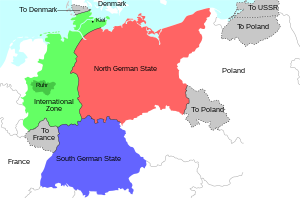
Back خطة مورغنثاو Arabic Morgentau planı Azerbaijani План Маргентау Byelorussian План „Моргентау“ Bulgarian Pla Morgenthau Catalan Morgenthauův plán Czech Cynllun Morgenthau Welsh Morgenthau-Plan German Σχέδιο Μοργκεντάου Greek Morgenthau-plano Esperanto


The Morgenthau Plan was a proposal to weaken Germany following World War II by eliminating its arms industry and removing or destroying other key industries basic to military strength. This included the removal or destruction of all industrial plants and equipment in the Ruhr. It was first proposed by United States Secretary of the Treasury Henry Morgenthau Jr. in a 1944 memorandum entitled Suggested Post-Surrender Program for Germany.[1]
While the Morgenthau Plan had some influence until 10 July 1947 (adoption of JCS 1779) on Allied planning for the occupation of Germany, it was not adopted. US occupation policies aimed at "industrial disarmament",[2] but contained a number of deliberate loopholes, limiting any action to short-term military measures and preventing large-scale destruction of mines and industrial plants, giving wide-ranging discretion to the military governor and Morgenthau's opponents at the War Department.[3][4] An investigation by Herbert Hoover concluded the plan was unworkable, and would result in up to 25 million Germans dying from starvation.[5] From 1947, US policies aimed at restoring a "stable and productive Germany" and were soon followed by the Marshall Plan.[3][6]
When the Morgenthau Plan was published by the US press in September 1944, it was immediately seized upon by the Nazi German government and used as part of propaganda efforts in the final seven months of the war in Europe that aimed to convince Germans to fight on.[7]
- ^ Cite error: The named reference
Original memorandumwas invoked but never defined (see the help page). - ^ Gareau 1961, p. 520.
- ^ a b Beschloss 2002, pp. 169–170.
- ^ Greiner 1995, pp. 199–204.
- ^ Reinert, Erik; Jomo, K. S. (2008). "The Marshall Plan at 60: The Generals Successful War on Poverty". UN Chronicle. 14. Archived from the original on 14 April 2008.
- ^ Greiner 1995, pp. 327–328.
- ^ Beschloss 2002, p. 144.